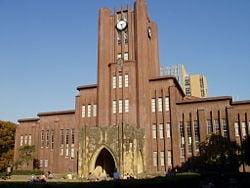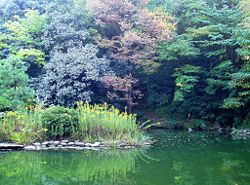University of Tokyo
| Established | 1877 |
|---|---|
| Type | Public |
| Location | Bunkyo, Tokyo Japan |
| Website | www.u-tokyo.ac.jp |
The University of Tokyo (東京大学; Tōkyō Daigaku, abbreviated as 東大 Tōdai) is one of the leading research universities in Japan. The University has five campuses in Hongo, Komaba, Kashiwa, Shirokane and Nakano and 10 faculties with a total of around 30,000 students, some 2,100 of them foreign (a large fraction by Japanese standards). While nearly all academic disciplines are taught at the University, it is perhaps best known for its faculties of law and literature. This university has produced many Japanese politicians, though the power of the school has been gradually decreasing. For example; the ratio of its alumni in prime ministers is 2/3, 1/2, 1/4, 1/5 and 1/6 in the 1950s, 60s, 70s, 80s and 90s respectively. The University of Tokyo is widely thought of as being one of the most prestigious schools over many areas while its rival schools are the other six of the Seven Universities, which were Imperial Universities before World War II, especially Kyoto University. In science, Kyoto University has produced more top scientists and Nobel prize winners. One of the presidents of Tokyo Imperial University was Kikuchi Dairoku.
It is one of the Tokyo 6 Universities in baseball.
The main Hongo campus occupies the former estate of the Maeda family, Edo period feudal lords of Kaga Province. The university's best known landmark, the Akamon (Red Gate) is a relic of this era. The symbol of the university is the ginkgo leaf, from the abundant trees throughout the area.
The university was founded by the Meiji government in 1877 under its current name by amalgamating older government schools for medicine and Western learning. It was renamed to Imperial University (帝國大學 Teikoku Daigaku) in 1886 and then "Tokyo Imperial University" (東京帝國大學 Tōkyō Teikoku Daigaku) in 1887, when the imperial university system was created. In 1947, after Japan's defeat in World War II, it assumed the original name again. With the start of the new university system in 1949, Tōdai swallowed up the old First Higher School (today's Komaba campus) and the old Tokyo Higher School, which henceforth assumed the duty of teaching first and second-year undergraduates, while the faculties on Hongo main campus took care of third and fourth-year students.
The University of Tokyo has since 2004 been incorporated as a national university corporation under a new law which applies to all national universities.
Despite the incorporation, which has led to increased financial independence and autonomy, The University of Tokyo is still partly controlled by the Ministry of Education, Culture, Sports, Science and Technology (MEXT, Monbukagakusho, or Monbusho).
Faculties and Graduate Schools
Faculties
- Law
- Medicine
- Engineering
- Letters
- Science
- Agriculture
- Economics
- Arts and Sciences
- Education
- Pharmaceutical Sciences
Graduate Schools
- Law and Politics
- Medicine
- Engineering
- Humanities and Sociology
- Science
- Agricultural and Life Sciences
- Economics
- Arts and Sciences
- Education
- Pharmaceutical Sciences
- Mathematical Sciences
- Frontier Sciences
- Information Science and Technology
- Interdisciplinary Information Studies
- Public Policy
Research Institutes
- Institute of Medical Science
- Earthquake Research Institute
- Institute of Oriental Culture
- Institute of Social Science
- Institute of Socio-Information and Communication Studies
- Institute of Industrial Science
- Historiographical Institute
- Institute of Molecular and Cellular Biosciences
- Institure for Cosmic Ray Research
- Institute for Solid State Physics
- Ocean Research Institute
Faculty members
- Basil Hall Chamberlain
- Shinichi Kitaoka, Japan's United Nations representative
- Dairoku Kikuchi
Notable alumni
Prime Ministers
- Shigeru Yoshida (1946-1947,1948-1954)
- Nobusuke Kishi (1957-1960)
- Eisaku Sato (1964-1972)
- Takeo Fukuda (1976-1978)
- Yasuhiro Nakasone (1982-1987)
- Kiichi Miyazawa (1991-1993)
Mathematicians
- Tadatoshi Akiba
- Kiyoshi Itō
- Kenkichi Iwasawa
- Yasumasa Kanada
- Kunihiko Kodaira
- Mikio Sato
- Goro Shimura
- Yutaka Taniyama
- Teiji Takagi
Architects
- Kenzo Tange
- Fumihiko Maki
- Arata Isozaki
- Toyo Ito
Authors
- Kobo Abe
- Akutagawa Ryunosuke
- Yasunari Kawabata, Nobel laureate
- Yukio Mishima, Author
- Wafu Nishijima, Zen Buddhist priest
- Mori Ogai
- Natsume Soseki
- Kenzaburo Oe, Nobel laureate
- Osamu Dazai (dropout)
In entertainment
- Isao Takahata, Anime director
- Mayuko Takata, Actress
- Rei Kikukawa, Actress
- Towa Oshima, Manga-ka
- Yoji Yamada, Movie director
- Koichi Sugiyama, Music composer
Others
- Ah Syong, Founder of Japanese Electric Pole
- Hisashi Owada, International Court of Justice Judge
- Toshihiko Fukui, Governor of the Bank of Japan
- Tadatoshi Akiba, Mayor of Hiroshima
- Leo Esaki, Physicist, Nobel laureate
- Masatoshi Koshiba, Physicist, Nobel laureate
- Hiroo Mori, Real Estate Developer
- Kitaro Nishida, Philosopher
- Ong Iok-tek, Linguist
- Princess Masako, Crown Princess
- Kitsune Ouzora, Founder of OGc and GGB
- Eiji Toyoda, Industrialist
- Daisetz Teitaro Suzuki, Buddhist scholar
- Manshi Kiyozawa, Buddhist thinker
- Toshihiko Atsuyama, professor of Japanese studies at Harvard University
- Watsuji Tetsuro, Philosopher
- Kazuhide "Mirrorman" Uekusa, Economist, former professor at Waseda University graduate school and sex offender
- Takashi Yuasa Lawyer, Economist
- Takafumi Horie, ex-CEO of Livedoor (dropout)
Sanshiro Pond
Sanshiro Pond, in the heart of the university's Hongo campus, dates to 1615. After the fall of the Osaka Castle, the Shogun gave this pond and its surrounding garden to Maeda Toshitsune. As Maeda Tsunanori further developed the garden, it became known as one of the most beautiful gardens in Edo (now Tokyo), with the traditional eight landscapes and eight borders, but also known for its originality in its artificial pond, hills, and pavilions. It was at that time known as Ikutoku-en (Garden of Teaching Virtue). The pond's contours are in the shape of the character kokoro or shin (heart), and thus its official name is Ikutoku-en Shinjiike. However it has been commonly called Sanshiro Pond since the publication of Natsume Soseki's novel Sanshiro.
University of Tokyo in fiction
- In the manga and anime Love Hina, the main character, Keitaro Urashima, is a student who adamantly wishes to enter the University of Tokyo and fails the entrance exam several times.
- The manga Dragon Zakura is about a poor lawyer—and former motorcycle gang member—who tries to make students from a high school with a poor academic standing enter the University of Tokyo directly upon graduation.
- The DC Comics character Superman is frequently seen in flashbacks as attending the University of Tokyo in his secret identity of Clark Kent.
- The teacher/stalker character Suguru Teshigawara from the popular manga and anime series Great Teacher Onizuka was educated at the University of Tokyo and often takes pride in his education.
University of Tokyo in nonfiction
- Manabu Miyazaki; Toppamono: Outlaw. Radical. Suspect. My Life in Japan's Underworld (2005, Kotan Publishing, ISBN 0970171625)
University of Tokyo in Asia
Top 100 Asia Pacific Universities(2005)
by Institute of Higher Education, Shanghai Jiao Tong University, China.
- The University of Tokyo
- Kyoto University
- Australian National University
- Osaka University
- Tohoku University
- Hebrew University of Jerusalem
- University of Melbourne
- Tokyo Institute of Technology
see rest at [1]
External links
Credits
New World Encyclopedia writers and editors rewrote and completed the Wikipedia article in accordance with New World Encyclopedia standards. This article abides by terms of the Creative Commons CC-by-sa 3.0 License (CC-by-sa), which may be used and disseminated with proper attribution. Credit is due under the terms of this license that can reference both the New World Encyclopedia contributors and the selfless volunteer contributors of the Wikimedia Foundation. To cite this article click here for a list of acceptable citing formats.The history of earlier contributions by wikipedians is accessible to researchers here:
The history of this article since it was imported to New World Encyclopedia:
Note: Some restrictions may apply to use of individual images which are separately licensed.

